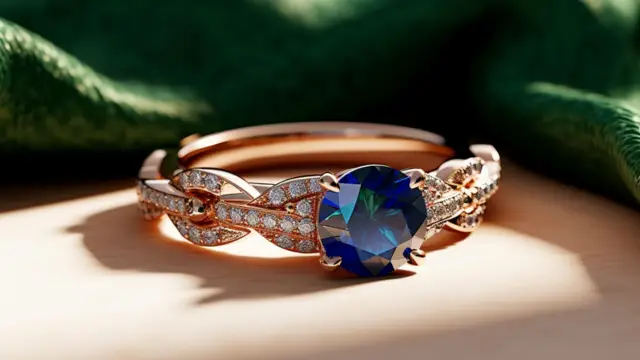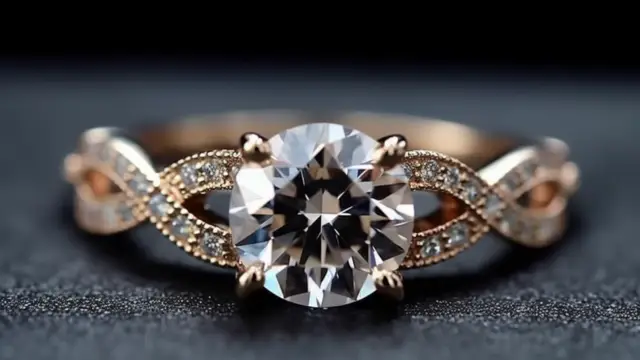Non-Traditional Engagement Rings: Say Yes To A New Trend
Gone are the days when a traditional solitaire diamond was the only option for an engagement ring. Nowadays, couples are opting for unique and personalized designs that express their individuality.
Enter the non-traditional engagement ring trend, offering an exciting range of stones, settings, and styles that will take your breath away.
Let Your Personality Shine Through
Are you looking for a ring that shouts ‘you’? A non-traditional engagement ring allows you to express yourself, your style, and your preference through the design of the ring. Whether it’s bright colors, emerald stones, rose gold settings, or a combination of all three – you can customize your ring in a way that no one else has!
Making A Statement With Ethics
Awareness of ethical and sustainable sourcing has led many couples to opt for non-traditional engagement rings. With options such as lab-grown diamonds, conflict-free stones, and recycled metals, it’s easy to make a statement with your ring choice while staying true to your personal values.

One-of-A-Kind Symbol of Love
Finding the perfect engagement ring is an unforgettable experience, and non-traditional designs offer the perfect way to make it even more memorable. Cherish a ring that reflects your personality and style, and enjoy a one-of-a-kind symbol of your love for years to come.
Why Choose Non-Traditional Diamond Engagement Rings
Non-traditional diamond engagement rings offer various advantages, including unique self-expression, ethical considerations, and budgetary benefits. They allow for self-expression and better represent individuality.
- Colored gemstones like sapphires, rubies, and emeralds are popular alternatives to traditional diamonds and offer a unique and vibrant look for the bride with an eye for color.
- Ethical considerations of the diamond industry prompt more couples to choose non-diamond options.
- Non-diamond engagement rings can be more budget-friendly.
- They can be a way to honor a cultural heritage or family history.
Types Of Non-Traditional Diamond Engagement Rings
Gemstone Rings
Non traditional wedding ring stones often showcase a variety of unique and colorful gemstones. Sapphires are popular, offering hues from deep blue to green and pink. Rubies are known for their rich red hue and durability, while emeralds bring a vibrant green touch to engagement rings.
Other non traditional gemstone engagement rings contain:
- Aquamarines, which have a serene blue color
- Pearls add elegance and sophistication
- Quartz, which can be found in various colors and patterns
- Peridot, featuring a bright green hue
- Morganite, known for its elegant soft pink hue
For those who prefer more unique non traditional engagement rings options, watermelon tourmalines, opals, garnets, and salt and pepper diamonds offer distinct and eye-catching appearances. Pink tourmaline and citrine are options for those seeking warm, bright colors in their engagement rings.
Alternative Metals
While gold and platinum are classic engagement ring metals, alternative metals can offer a unique and modern twist to traditional rings. Sterling silver is a more affordable option while still maintaining beauty and durability.
Other alternative metals to consider for non-traditional diamond engagement rings include:
- Tungsten
- Titanium
- Stainless steel
- Cobalt
These metals offer different hues and strengths, allowing for more customization in ring design.

Unique Settings
Non-traditional diamond engagement rings also embrace creative and innovative settings. For example, asymmetrical arrangements or clusters can give a ring a modern and artistic feel, while three-stone settings showcase a trilogy of gorgeous gemstones, such as aquamarine.
Other unique settings include:
- Bezel settings, which encase the gemstone entirely in metal for added protection
- Vintage-inspired designs incorporating intricate filigrees and engravings
- Hidden halo designs add extra sparkle to the ring without overtaking the center stone
Non-traditional diamond engagement rings offer a wide range of styles and materials, creating an opportunity for a unique and personalized ring design that reflects the love shared between two people.
Popular Non-Traditional Engagement Rings Designs And Styles
One popular design for non-traditional diamond engagement rings is using gemstones other than diamonds. For instance, rings with pearls, rubies, emeralds, and sapphires create a distinctive look and are often more affordable.
In addition, these gemstones can be set in various metals, including 14k yellow gold and 14k white gold, which are durable and suitable for daily wear.
Another attractive option for a non-traditional engagement ring design is the halo setting. This style features a central gemstone surrounded by smaller diamonds, creating an illusion of a larger centerpiece.
In addition, the halo setting can be used with various gems, adding a touch of elegance and glamour to the design. 14k yellow gold and 14k white gold are popular halo settings, with white gold often providing a more contemporary appearance.
Pavé bands also add a unique element to non-traditional engagement rings. These bands are characterized by small diamonds set closely together along the band, giving the appearance of a continuous row of diamonds.
Pavé bands can be incorporated into various ring styles, including those with halo settings or alternative center stones. In addition, they can be crafted in 14k yellow gold and 14k white gold, allowing for customization based on the wearer’s preferences.
Non-Traditional Celebrity Engagement Rings
Celebrities are known for setting trends and making bold statements; their engagement rings are no exception to this rule. Regarding unique and unconventional choices, several stars have opted for non-traditional diamond engagement rings that stand out.
One famous example is the engagement ring of Kate Middleton, who wears a 12-carat Ceylon sapphire ring that once belonged to her late mother-in-law, Princess Diana. The deep blue sapphire is surrounded by a halo of diamonds, making it one of the most iconic non-diamond rings ever.
Another celebrity with a non-traditional engagement ring is actress Emma Stone. Instead of the conventional diamond, Stone’s ring features an 8mm round pearl set into beige gold, creating a simple yet elegant look.
Lily Collins showcased her unique taste with a morganite center stone engagement ring. Morganite, a pink-hued gemstone, offers a romantic alternative to a traditional diamond and has grown in popularity in recent years.
Non-traditional diamond engagement rings can showcase a variety of designs and colors. Some celebrities who have opted for colorful stones include:
- Elizabeth Hurley: square-cut sapphire rimmed by two trillion-cut white diamonds.
- Rebecca Romijn: yellow diamond engagement ring
These alternative engagement rings not only make a statement but potentially come with practical benefits as well. For example, selecting a non-diamond center stone can sometimes result in a more affordable non traditional engagement ring option without compromising style or quality.

Ethical And Conflict-Free Diamonds
Ethical and conflict-free diamonds are becoming increasingly popular as more people seek to make responsible choices when purchasing engagement rings.
These diamonds are sourced in ways that prioritize fair labor practices and environmental sustainability and contribute positively to the communities in which they are mined.
One option for ethically sourced diamonds is Canadian diamonds. They are mined under strict environmental procedures and fair working conditions, which makes them a more ethical choice than some traditionally sourced diamonds.
In addition, although Canadian diamonds tend to be slightly more expensive than their African counterparts, their transparent supply chain ensures they are genuine conflict-free diamonds.
Another approach to ethical diamonds is Beyond Conflict Free™ diamonds offered by Brilliant Earth. This initiative goes beyond the Kimberley Process, which defines conflict diamonds as rough diamonds used to finance wars against governments.
Beyond Conflict Free™ diamonds ensure that the entire supply chain, from mining to processing, is transparent and sustainable and supports local communities.
Some companies also offer engagement rings made with recycled gold and diamonds, minimizing the need for further mining. For example, Catbird produces its jewelry using recycled gold and diamonds and adheres to ethical practices in Brooklyn, New York.
When considering non-traditional diamond engagement rings, shoppers should look for companies that clearly state their commitment to ethical and conflict-free sourcing.
By choosing ethically sourced diamonds, consumers can support a more transparent and sustainable jewelry industry and positively impact the communities involved in diamond production.

Purchasing Tips And Seller Recommendations
When shopping for non-traditional diamond engagement rings, keeping a few critical factors in mind is crucial to ensure you make the best purchase.
First, familiarize yourself with the 4Cs of diamond quality: carat, cut, clarity, and color. Understanding these factors will help you make informed decisions about the quality of the diamond you choose, GIA 4Cs.
Next, consider the design and style of the ring. Non-traditional engagement rings often feature unique settings, shapes, and gemstones. Consider choosing a ring with an alternative gemstone, such as a sapphire or emerald, for a more personalized touch.
Regarding where to buy non-traditional diamond engagement rings, online retailers like Etsy offer various unique options from independent sellers. Many Etsy sellers also offer free shipping, making the purchase process even more attractive.
Major cities like Los Angeles, New York, San Diego, and Washington D.C. also have local independent jewelers with diverse selections of non-traditional engagement rings.
To compare various sellers, consider the following criteria:
- Reputation: Look for a seller with a strong reputation, both from customer reviews and industry endorsements.
- Pricing: Explore your options to ensure you’re getting good value for your investment.
- Shipping: When shopping online, consider a seller that offers free shipping to save on costs.
Here are a few recommended sellers based on different locations:
Los Angeles
- Sofia Kaman Fine Jewels
- Trumpet & Horn
New York
- Catbird
- Gray & Davis
San Diego
- Vanessa Nicole Jewels
- Rustic and Main
Washington D.C.
- Tiny Jewel Box
- Cherry Blossom Creative
By carefully considering the purchase criteria and exploring seller options, you can make an informed decision when buying a non-traditional diamond engagement ring that suits your unique style and budget.
Frequently Asked Questions
Are Non-Diamond Engagement Rings Tacky?
Non-diamond engagement rings are far from tacky. They offer a unique and personal touch, better value for cost, environmental benefits, and the chance to celebrate traditions from around the world.
1. Diamonds Aren’t Always a Girl’s Best Friend
Diamonds have long been seen as the go-to stone for engagement rings, even though their value is artificially inflated, and they’re not the only option for a beautiful ring. A non-diamond stone, like a sapphire or a ruby, is a colorful and unique choice that can reflect your almost-betrothed’s personality flawlessly.
The tradition of diamond rings is relatively new, with jewelers promoting them in the 1930s. Before that, engagement rings were typically simpler and less expensive–something most brides-to-be today can also appreciate. In comparison, non-diamond engagement rings can save money without losing the beauty or unique symbolization of your love.
2. Ditch the De Beers Myths
If you’ve heard that non-diamond engagement rings are a sign of love that lacks commitment, it’s time to most these De Beers myths. In America, De Beers is a monopoly that has marketed diamonds as a standard for engagement rings since the early 20th century.
It’s as simple as that – they are in the business of selling diamonds and have been for almost 100 years. Therefore, diamond rings should not be considered the only option for a symbol of love but more like a product of marketing. Engagement rings should represent your own love story, not something out of a corporate handbook.
3. Not Just a Diamond Cut
In addition to colored stones, non-diamond engagement rings also offer stunning options in silver, gold, platinum, and unique shapes that diamonds can’t always pull off. These rings can be customized with engravings or other features unique to your love story for that extra touch of romance.
4. Investment
If you’re concerned about the value of your engagement ring, the price tags on diamond rings and non-diamond rings are not that far apart. You might be surprised by the long-term investment any stone or metal can prove to be. In the long run, you’ll ultimately miss out on the opportunity to make more memorable moments if you overspend on a ring you can’t afford.
5. Eco-Friendly and Ethical
Finally, opting for a non-diamond engagement ring might also be more environmentally conscious and ethical. Consider lab-grown diamonds or ethically-sourced stones when looking for your perfect ring.
There are a ton of jewelry-makers out there working with eco-friendly materials, so it’s worth considering not just for the sake of the environment but also to feel good about the values represented by your piece.
Is It OK To Get A Non-Diamond Engagement Ring?
There are plenty of reasons to consider a non-diamond engagement ring. From affordability and sustainability to unique designs and symbolism, these rings are perfect for modern couples. Rather than prioritizing expensive diamonds, couples are taking a creative route by choosing unconventional gemstones that represent their personalities and love stories.
When it comes to engagement rings, there is no one size fits all, so whichever stone you choose, make sure it resonates with you and your partner.


